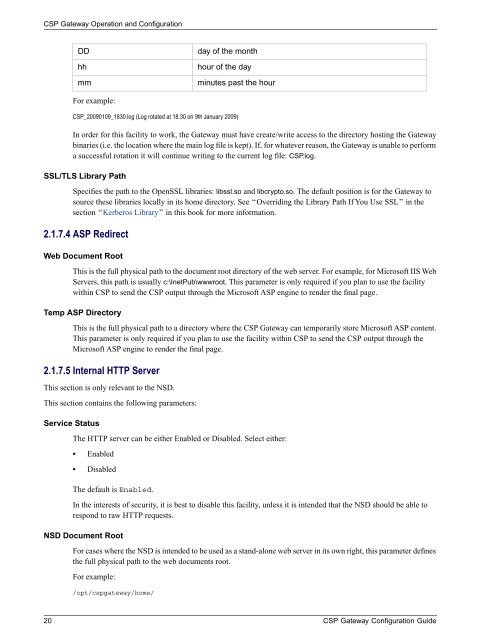CSP Gateway Configuration Guide - InterSystems Documentation
CSP Gateway Configuration Guide - InterSystems Documentation
CSP Gateway Configuration Guide - InterSystems Documentation
You also want an ePaper? Increase the reach of your titles
YUMPU automatically turns print PDFs into web optimized ePapers that Google loves.
<strong>CSP</strong> <strong>Gateway</strong> Operation and <strong>Configuration</strong><br />
DD<br />
hh<br />
mm<br />
day of the month<br />
hour of the day<br />
minutes past the hour<br />
For example:<br />
<strong>CSP</strong>_20090109_1830.log (Log rotated at 18:30 on 9th January 2009)<br />
In order for this facility to work, the <strong>Gateway</strong> must have create/write access to the directory hosting the <strong>Gateway</strong><br />
binaries (i.e. the location where the main log file is kept). If, for whatever reason, the <strong>Gateway</strong> is unable to perform<br />
a successful rotation it will continue writing to the current log file: <strong>CSP</strong>.log.<br />
SSL/TLS Library Path<br />
Specifies the path to the OpenSSL libraries: libssl.so and libcrypto.so. The default position is for the <strong>Gateway</strong> to<br />
source these libraries locally in its home directory. See “Overriding the Library Path If You Use SSL” in the<br />
section “Kerberos Library” in this book for more information.<br />
2.1.7.4 ASP Redirect<br />
Web Document Root<br />
This is the full physical path to the document root directory of the web server. For example, for Microsoft IIS Web<br />
Servers, this path is usually c:\InetPub\wwwroot. This parameter is only required if you plan to use the facility<br />
within <strong>CSP</strong> to send the <strong>CSP</strong> output through the Microsoft ASP engine to render the final page.<br />
Temp ASP Directory<br />
This is the full physical path to a directory where the <strong>CSP</strong> <strong>Gateway</strong> can temporarily store Microsoft ASP content.<br />
This parameter is only required if you plan to use the facility within <strong>CSP</strong> to send the <strong>CSP</strong> output through the<br />
Microsoft ASP engine to render the final page.<br />
2.1.7.5 Internal HTTP Server<br />
This section is only relevant to the NSD.<br />
This section contains the following parameters:<br />
Service Status<br />
The HTTP server can be either Enabled or Disabled. Select either:<br />
• Enabled<br />
• Disabled<br />
The default is Enabled.<br />
In the interests of security, it is best to disable this facility, unless it is intended that the NSD should be able to<br />
respond to raw HTTP requests.<br />
NSD Document Root<br />
For cases where the NSD is intended to be used as a stand-alone web server in its own right, this parameter defines<br />
the full physical path to the web documents root.<br />
For example:<br />
/opt/cspgateway/home/<br />
20 <strong>CSP</strong> <strong>Gateway</strong> <strong>Configuration</strong> <strong>Guide</strong>

















